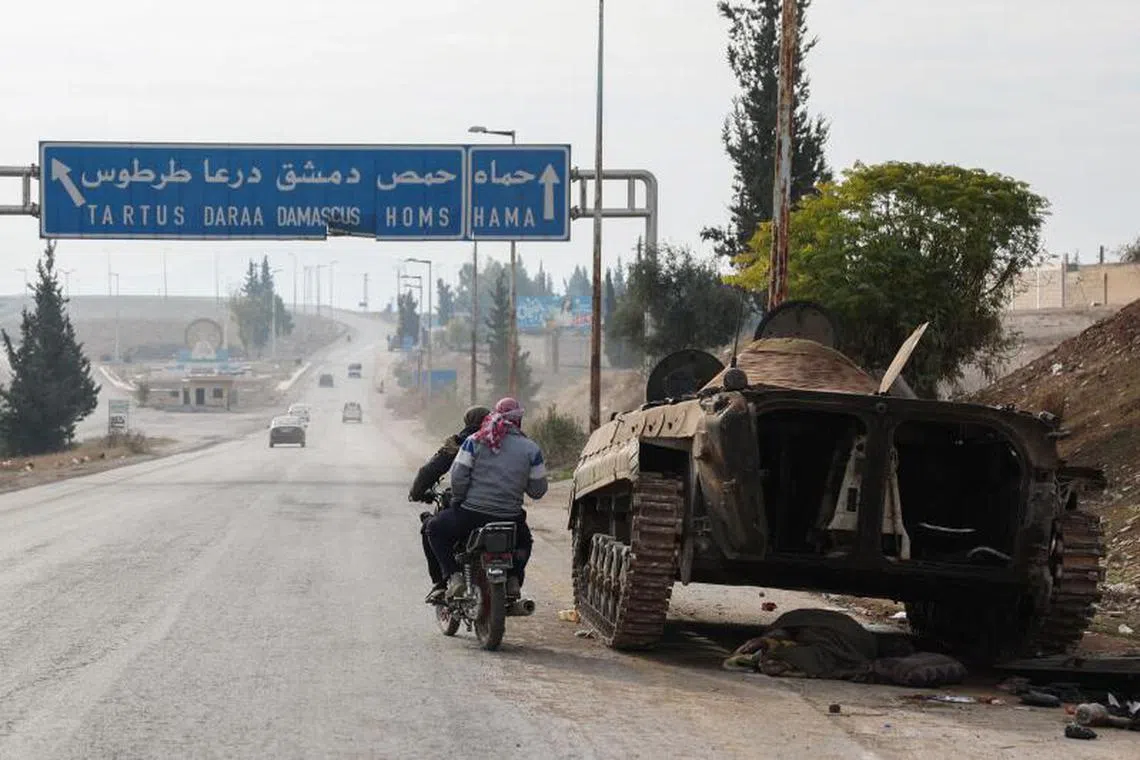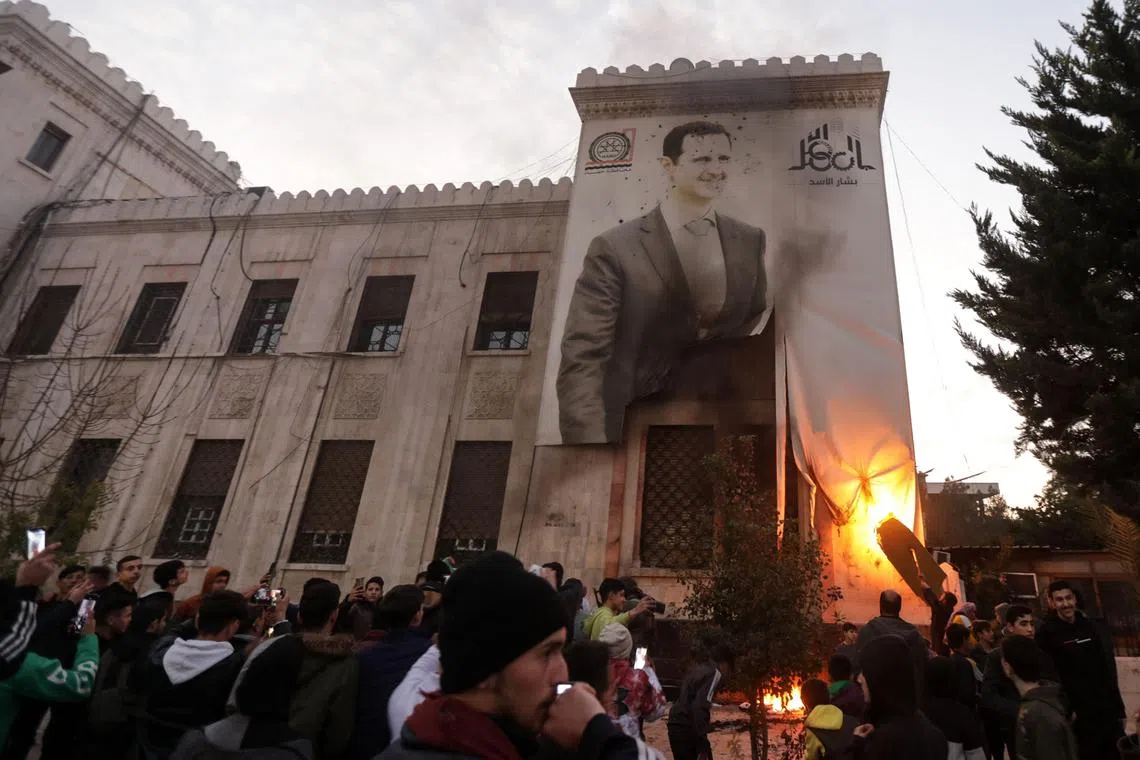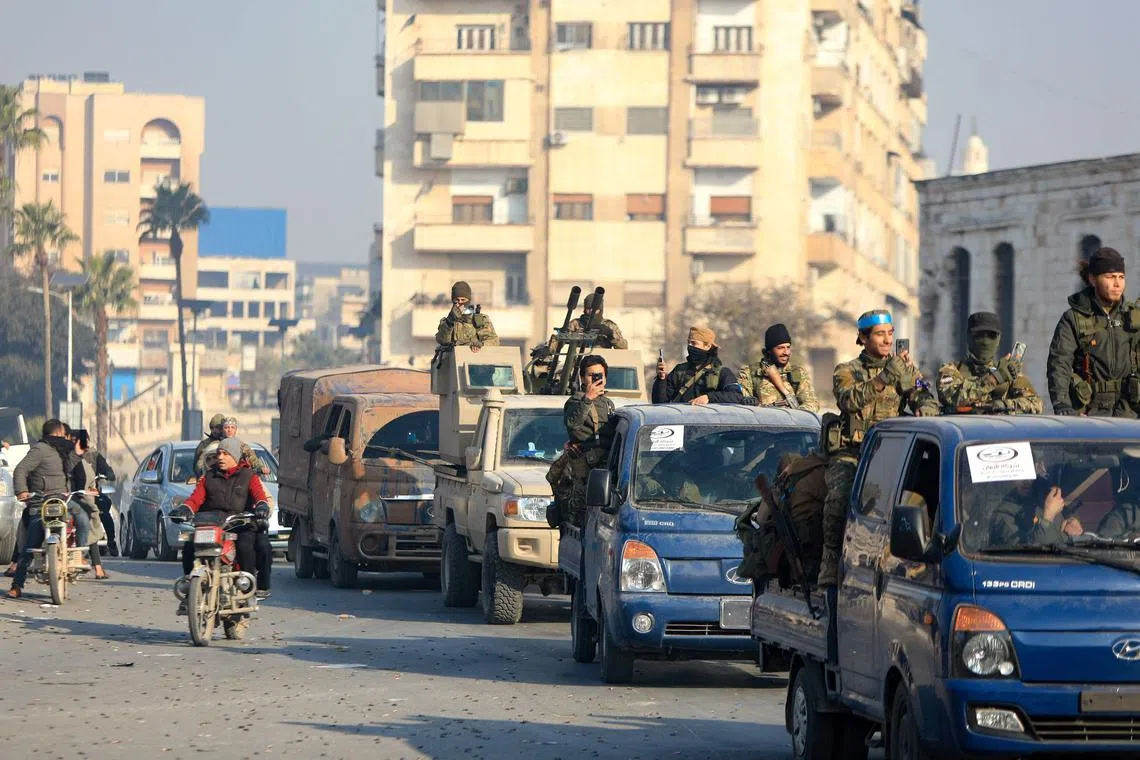Syria rebels say nearing Damascus as UN envoy urges ‘calm’ and ‘avoidance of bloodshed’
Sign up now: Get ST's newsletters delivered to your inbox

Follow topic:
BEIRUT - Rebels on a lightning advance through Syria said they were nearing Damascus on Dec 7, as the United Nations special envoy to Syria called for “de-escalation” and “calm” to avoid bloodshed.
“Our forces have begun the final phase of encircling the capital,” said rebel commander Hassan Abdel Ghani, with the Islamist-led alliance that launched the offensive.
The leader of Hayat Tahrir al-Sham (HTS), the Islamist group which has headed the assault, told fighters to prepare to take the seat of Assad’s government, just over a week into a renewed offensive in the long dormant conflict.
“Damascus awaits you,” said HTS’s Ahmed al-Sharaa in a statement on Telegram, using his real name instead of his nom de guerre, Abu Mohammed al-Jolani.
The Syrian army said it was strengthening its defence lines around Damascus and in the south on Dec 7, as panic spread in the capital after the rebels said they were drawing close.
“Our armed units are reinforcing their lines throughout the Damascus countryside and the southern region,” a spokesperson for the General Command of the Army and Armed Forces said in a televised statement.
He also said the army was launching operations against rebels in the “Hama and Homs countrysides (in central Syria) and the northern Daraa countryside” in the south.
Syria’s defence ministry had earlier said that “there is no truth to news claiming our armed forces... have withdrawn” from positions near Damascus.
AFP has been unable to independently verify some of the information provided by the government and the rebels, as its journalists in Syria cannot reach the areas around Damascus where the rebels say they are present.
The United Nations special envoy to Syria, Geir Pedersen, called on Dec 7 for calm in the country following rapid advances by Islamist-led rebels.
“I reiterate my call for de-escalation, for calm, for the avoidance of bloodshed and the protection of civilians in line with international humanitarian law,” Mr Pedersen said at the Doha Forum for political dialogue, urging “the start of a process that leads to the realisation of the legitimate aspirations of the Syrian people”.
Mr Pedersen said he had called in meetings for “urgent political talks in Geneva to implement Security Council Resolution 2254“ of 2015, which set out a roadmap for a negotiated settlement.
“My hope is that it will be able to announce a date for this very soon. The need for an orderly political transition has never been more urgent, starting with the urgent formation of inclusive and credible transitional arrangements,” he said.
In a Damascus suburb on Dec 7, witnesses said protesters toppled a statue of the late president Hafez al-Assad, who handed Syria’s rule to his son.

A truck pulls the head of the toppled statue of late Syrian president Hafez al-Assad through the streets of the captured central-west city of Hama on Dec 6.
PHOTO: AFP
Similar scenes were witnessed in images shared by local media in the southern city of Daraa and in online footage verified by AFP from Hama, north of the capital.
In Hama, an AFP photographer saw residents set fire to a giant poster of President Assad on the facade of city hall.

Residents in Hama set ablaze a large banner bearing a picture of Syrian President Bashar-al-Assad hanging on the facade of a municipal building.
PHOTO: AFP
“The rebels entered Hama, it was a great joy for us – something we had been waiting for since 2011,” said resident Maymouna Jawad, of the year Assad’s crackdown on democracy protests escalated into civil war.
Syria’s presidency denied reports that Mr Assad had left Damascus, saying he was “following up on his work and national and constitutional duties from the capital”.
The HTS leader said in a CNN interview published on Dec 6 that “the goal of the revolution remains the overthrow of this regime”.
Fears of ‘chaos’
As government forces fall back in the face of the offensive gathering even more momentum, a war monitor and Mr Abdel Ghani said rebels were within 20km of Damascus.
The Syrian Observatory for Human Rights said government forces had ceded more key ground, losing control of all of southern Daraa province, cradle of the 2011 uprising.
The army said it was “redeploying and repositioning” in Daraa and another southern province, Sweida.
The Britain-based Observatory said troops were also evacuating posts in Quneitra, near the Israeli-annexed Golan Heights where Israel said it was boosting its troop presence.
Jordan has urged its citizens to leave neighbouring Syria “as soon as possible”, as have Assad ally Russia and the United States, which both keep troops in Syria.
After the HTS-led rebels seized Aleppo and Hama
An AFP correspondent in Daraa saw local fighters guarding public property and civil institutions on Saturday.
In Sweida city, a local fighter told AFP that after government forces had withdrawn “from their positions and headquarters, we are now securing and protecting vital facilities”.
“We must remain vigilant to avoid descending into chaos, as chaos will harm everyone.”
In the central Homs area, a key stepping stone to Damascus, the Observatory said government forces had brought “large reinforcements” and stopped the rebel advance.
By Dec 6, the government was also pulling troops out of Deir Ezzor in the east, with Kurdish-led forces saying they had moved in.
An Iraqi security source told AFP that Baghdad has allowed in hundreds of Syrian soldiers who “fled the front lines” and entered through the Al-Qaim border crossing, the Syrian side of which is in Deir Ezzor province. A second source put the figure at 2,000 troops, including officers.

Anti-government fighters parade in the streets of Hama after forces captured the central city, on Dec 6.
PHOTO: AFP
‘Find peace’
HTS is rooted in the Syrian branch of Al-Qaeda. Proscribed as a terrorist organisation by Western governments, it has sought to soften its image in recent years.
As the Islamist rebels seize more territory, they have sought to reassure minority groups living in areas now under their control.
“We ask that all sects be reassured... for the era of sectarianism and tyranny has gone away forever,” said Abdel Ghani.
Since the offensive began last week, at least 826 people, mostly combatants but also including 111 civilians, have been killed, according to the Observatory.
The United Nations said the violence has displaced 370,000 people.
US Secretary of State Antony Blinken called for a “political solution to the conflict”, his spokesperson said Dec 6, in a call with Turkish Foreign Minister Hakan Fidan.
Mr Fidan, his Iranian and Russian counterparts discussed Syria in Qatar on Dec 7.
Iran’s Foreign Minister Abbas Araghchi said the parties agreed on the initiation of “political dialogue between the Syrian government and the legitimate opposition groups”.
Russia’s top diplomat Sergei Lavrov said it was “inadmissible” to allow a “terrorist group to take control” of Syrian territory.
Moscow and Tehran have supported Assad’s government and army during the war, as has Lebanese armed group Hezbollah.
A source close to the group said Hezbollah had sent 2,000 fighters into Syria, to an area near the Lebanese border, “to defend its positions”.
Turkish President Recep Tayyip Erdogan, whose government backs armed groups in north Syria and has sent ground forces across the border numerous times since 2016, said on Saturday that Syria “is tired of war, blood and tears”.
“Our wish is for our neighbour, Syria, to find the peace and tranquility it has been dreaming of for 13 years.” AFP

